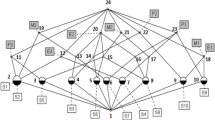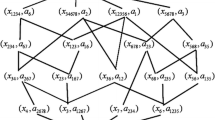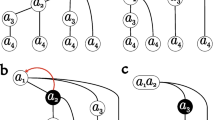Abstract
The concept lattice plays a fundamental role in formal concept analysis (FCA) and finds widespread application across various fields. However, the presence of a large number of nodes in the concept lattice can pose challenges when it comes to comprehending the acquired conceptual knowledge. The size of the concept lattice is a significant concern in FCA, and obtaining an appropriately sized lattice is of utmost importance. To address this issue, this paper introduces a novel model for identifying important concepts in the concept lattice. The proposed model leverages concept indices and complex network analysis techniques to reduce the size of the lattice and enhance the understanding of conceptual knowledge. To derive the most valuable concepts, concept indices are first proposed by both node attribute information and structural information. Second, to fuse the attribute and structural information of concepts, an information system for concept indices is developed. In addition, the K-means method is employed to comprehensively evaluate all concept indices and obtain important concept identification results. Finally, an empirical study and comparative analyze demonstrate that the proposed model can effectively identify important concepts in the concept lattice.
Access this chapter
Tax calculation will be finalised at checkout
Purchases are for personal use only
Similar content being viewed by others
References
Agrawal, R., Imieliński, T., Swami, A.: Mining association rules between sets of items in large databases. In: Proceedings of the 1993 ACM SIGMOD International Conference on Management of Data, pp. 207–216 (1993)
Dias, S.M., Vieira, N.J.: A methodology for analysis of concept lattice reduction. Inf. Sci. 396, 202–217 (2017)
Gao, J., Hao, F., Pei, Z., Min, G.: Learning concept interestingness for identifying key structures from social networks. IEEE Trans. Netw. Sci. Eng. 8(4), 3220–3232 (2021)
Hao, F., Gao, J., Bisogni, C., Min, G., Loia, V., De Maio, C.: Stability of three-way concepts and its application to natural language generation. Pattern Recogn. Lett. 149, 51–58 (2021)
Hao, F., Gong, Y., Yu, W., Loia, V.: Knowledge points navigation based on three-way concept lattice for autonomous learning. Pattern Recogn. Lett. 163, 96–103 (2022)
Klimushkin, M., Obiedkov, S., Roth, C.: Approaches to the selection of relevant concepts in the case of noisy data. In: Kwuida, L., Sertkaya, B. (eds.) ICFCA 2010. LNCS (LNAI), vol. 5986, pp. 255–266. Springer, Heidelberg (2010). https://doi.org/10.1007/978-3-642-11928-6_18
Kuznetsov, S.O.: On stability of a formal concept. Ann. Math. Artif. Intell. 49(1), 101–115 (2007)
Kuznetsov, S.O., Makhalova, T.: On interestingness measures of formal concepts. Inf. Sci. 442, 202–219 (2018)
Van der Maaten, L., Hinton, G.: Visualizing data using t-SNE. J. Mach. Learn. Res. 9(11), 2579–2605 (2008)
Mi, Y., Shi, Y., Li, J., Liu, W., Yan, M.: Fuzzy-based concept learning method: exploiting data with fuzzy conceptual clustering. IEEE Trans. Cybern. 52(1), 582–593 (2020)
Mouakher, A., Yahia, S.B.: On the efficient stability computation for the selection of interesting formal concepts. Inf. Sci. 472, 15–34 (2019)
Namtirtha, A., Dutta, A., Dutta, B.: Weighted kshell degree neighborhood: a new method for identifying the influential spreaders from a variety of complex network connectivity structures. Expert Syst. Appl. 139, 112859 (2020)
Pang, K., Liu, P., Li, S., Zou, L., Lu, M., Martínez, L.: Concept lattice simplification with fuzzy linguistic information based on three-way clustering. Int. J. Approximate Reasoning 154, 149–175 (2023)
Rudolf, W.: Restructuring lattice theory: an approach based on hierarchies of concept. In: Symposium on Ordered Sets 1982 (1982)
Singh, P.K., Kumar, C.A.: Concept lattice reduction using different subset of attributes as information granules. Granular Comput. 2(3), 159–173 (2017)
Xu, W., Guo, D., Mi, J., Qian, Y., Zheng, K., Ding, W.: Two-way concept-cognitive learning via concept movement viewpoint. IEEE Trans. Neural Netw. Learn. Syst. 34(10), 6798–6812 (2023)
Zhang, Y., Huang, G.: Identifying network structure characteristics and key factors for the co-evolution between high-quality industrial development and ecological environment. Environ. Dev. Sustain. 25(7), 6591–6625 (2023)
Zhao, S., Qi, J., Li, J., Wei, L.: Concept reduction in formal concept analysis based on representative concept matrix. Int. J. Mach. Learn. Cybern. 14(4), 1147–1160 (2023)
Acknowledgments
This work is supported by the National Natural Science Foundation of China (Nos. 61976124, 62176142) and the Talent Fund of Weihai Institute of Beijing Jiaotong University (No. 2024WHRC001).
Author information
Authors and Affiliations
Corresponding author
Editor information
Editors and Affiliations
Ethics declarations
Disclosure of Interests
The authors have no competing interests to declare that are relevant to the content of this article.
Rights and permissions
Copyright information
© 2024 The Author(s), under exclusive license to Springer Nature Switzerland AG
About this paper
Cite this paper
Pang, K., Wang, Z., Zou, L., Lu, M. (2024). Identifying Important Concepts in the Concept Lattice Based on Concept Indices. In: Hu, M., Cornelis, C., Zhang, Y., Lingras, P., Ślęzak, D., Yao, J. (eds) Rough Sets. IJCRS 2024. Lecture Notes in Computer Science(), vol 14840. Springer, Cham. https://doi.org/10.1007/978-3-031-65668-2_8
Download citation
DOI: https://doi.org/10.1007/978-3-031-65668-2_8
Published:
Publisher Name: Springer, Cham
Print ISBN: 978-3-031-65667-5
Online ISBN: 978-3-031-65668-2
eBook Packages: Computer ScienceComputer Science (R0)




